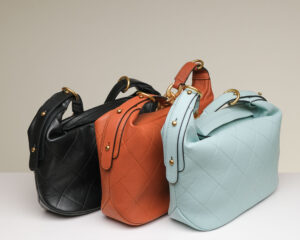From the humble beginnings of practical pouches to the iconic fashion statements we see today, the history of women’s purses is a fascinating journey through time. These essential accessories have evolved in design, function, and significance, reflecting the cultural and social changes across centuries. Join us as we explore the rich history of women’s purses in and celebrate their enduring allure.
The Early Beginnings: Practicality Meets Necessity
The origins of women’s purses in Europe can be traced back to the medieval period, where practicality reigned supreme. During this time, both men and women carried small pouches or “purses” attached to their belts. These early purses, often made of leather or fabric, were used to carry coins, keys, and other small necessities. They were simple in design, serving the primary purpose of convenience.
The Renaissance: Fashion Begins to Influence
The Renaissance period marked a shift in the perception of purses as purely functional items. As fashion began to play a more prominent role in society, purses evolved to reflect this change. Women started to carry more ornate and decorated pouches, often crafted from luxurious materials such as silk, velvet, and leather. Embroidery, beadwork, and intricate designs became popular, turning purses into fashionable accessories that showcased one’s status and style.
The 18th Century: The Rise of the Reticule
The 18th century brought about significant changes in women’s fashion, and with it, the emergence of the reticule. Known as the precursor to the modern handbag, the reticule was a small, drawstring bag that women carried by hand or on their wrist. This period saw the decline of bulky skirts and the rise of slimmer silhouettes, which rendered the traditional belt-attached pouches impractical. The reticule, often adorned with delicate embroidery and tassels, became an essential accessory for fashionable women.
The 19th Century: Industrial Revolution and Mass Production
The Industrial Revolution of the 19th century had a profound impact on the production and accessibility of purses. With the advent of mass production, purses became more affordable and widely available. This era also saw the introduction of various styles, including the iconic carpet bag and the elegant chatelaine. Leather became a popular material due to its durability and versatility, paving the way for the modern leather handbags we know today.
The Early 20th Century: The Birth of Iconic Brands
The early 20th century was a golden age for fashion, with the emergence of iconic designer brands that revolutionized the handbag industry. Designers like Coco Chanel, Louis Vuitton, and Hermès introduced stylish and luxurious handbags that became coveted symbols of elegance and sophistication. The classic Chanel 2.55 and the Hermès Kelly bag are just a few examples of timeless designs that continue to influence handbag fashion.
The Mid to Late 20th Century: Innovation and Diversity
The mid to late 20th century saw a surge in creativity and innovation in handbag design. With the rise of the women’s liberation movement, handbags became more than just fashion statements; they symbolized independence and empowerment. Designers experimented with new materials, shapes, and styles, offering a diverse range of options to suit every woman’s taste and lifestyle. From the playful and colorful designs of the 1960s to the minimalist and practical bags of the 1990s, this period was marked by a dynamic evolution in handbag fashion.
The 21st Century: A Blend of Tradition and Modernity
In the 21st century, women’s purses continue to blend tradition with modernity. While classic designs remain popular, there is a growing emphasis on sustainability and ethical practices in handbag production. Many brands are now focusing on eco-friendly materials and transparent supply chains, ensuring that fashion and responsibility go hand in hand. Additionally, the digital age has influenced handbag designs, with features like built-in chargers and compartments for electronic devices becoming increasingly common.






